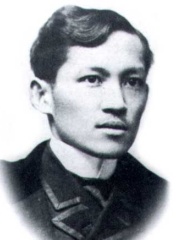
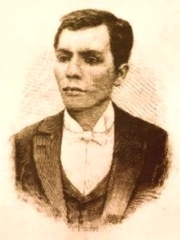
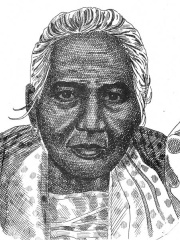
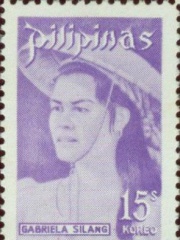
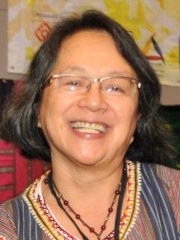
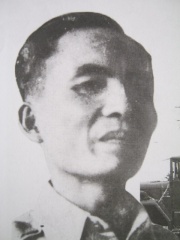


The Most Famous
SOCIAL ACTIVISTS from Philippines
This page contains a list of the greatest Filipino Social Activists. The pantheon dataset contains 840 Social Activists, 9 of which were born in Philippines. This makes Philippines the birth place of the 24th most number of Social Activists behind Switzerland, and Iraq.
Top 9
The following people are considered by Pantheon to be the most legendary Filipino Social Activists of all time. This list of famous Filipino Social Activists is sorted by HPI (Historical Popularity Index), a metric that aggregates information on a biography's online popularity.

1. José Rizal (1861 - 1896)
With an HPI of 71.83, José Rizal is the most famous Filipino Social Activist. His biography has been translated into 76 different languages on wikipedia.
José Protasio Rizal Mercado y Alonso Realonda (Spanish: [xoˈse riˈsal, -ˈθal], Tagalog: [hoˈse ɾiˈsal]; June 19, 1861 – December 30, 1896) was a Filipino nationalist, writer and polymath active at the end of the Spanish colonial period of the Philippines. He is popularly considered a national hero of the Philippines. An ophthalmologist by profession, Rizal became a writer and a key member of the Filipino Propaganda Movement, which advocated political reforms for the colony under Spain. He was executed by the Spanish colonial government for the crime of rebellion after the Philippine Revolution broke out; the revolution was inspired by his writings. Though he was not actively involved in its planning or conduct, he ultimately approved of its goals, which eventually resulted in Philippine independence. Rizal is widely considered one of the greatest and most influential figures in the Philippines, and has been recommended to be so honored by an officially empaneled National Heroes Committee. However, no law, executive order or proclamation has been enacted or issued officially proclaiming any Filipino historical figure as a national hero. He wrote the novels Noli Me Tángere (1887) and El filibusterismo (1891), which together are taken as a national epic, in addition to numerous poems and essays.

2. Andrés Bonifacio (1863 - 1897)
With an HPI of 64.99, Andrés Bonifacio is the 2nd most famous Filipino Social Activist. His biography has been translated into 42 different languages.
Andrés Bonifacio y de Castro (Tagalog: [anˈdɾes (anˈdɾez-) bonɪˈfaʃo], Spanish: [anˈdɾes βoniˈfaθjo]; November 30, 1863 – May 10, 1897) was a Filipino revolutionary leader. He is often called "The Father of the Philippine Revolution", and considered a national hero of the Philippines. He was a co-founder and later Kataastaasang Pangulo (Spanish: Presidente Supremo, “Supreme President”, often shortened by contemporaries and historians to Supremo) of the Kataastaasan, Kagalanggalang Katipunan ng mga Anak ng Bayan more commonly known as the "Katipunan", a movement that sought the independence of the Philippines from Spanish colonial rule and started the Revolution. Bonifacio reorganized the Katipunan into a revolutionary government, with himself as Pangulo (President) of a nation-state called Haring Bayang Katagalugan (“Sovereign Nation of the Tagalog People” or “Sovereign Tagalog Nation”), also Republika ng Katagaluguan (Spanish: República Tagala, “Tagalog Republic”), wherein "Tagalog" referred to all those born in the Philippine Islands and not merely in Tagalog-speaking regions Hence, some historians have argued that he should be considered the First President of the Tagalogs instead of the Philippines; that is why he is not included in the official list of Presidents. Bonifacio was executed in 1897 by Major Lázaro Macapagal under orders of the Consejo de la Guerra (Council of War) led by General Mariano Noriel, on the basis of committing sedition and treason against the government. In retrospective decades, Bonifacio is now considered one of the greatest, most influential and prominent historical figures in the Philippines for his revolution.

3. Melchora Aquino (1812 - 1919)
With an HPI of 57.44, Melchora Aquino is the 3rd most famous Filipino Social Activist. Her biography has been translated into 20 different languages.
Melchora Aquino (January 6, 1812 – February 19, 1919) was a Filipino revolutionary. She became known as "Tandang Sora" ("tandang" meaning "old") because of her old age during the Philippine Revolution (1896-1899). She was also known as the "Grand Woman of the Revolution" and the "Mother of Balintawak" for her contributions.

4. Gabriela Silang (1731 - 1763)
With an HPI of 56.29, Gabriela Silang is the 4th most famous Filipino Social Activist. Her biography has been translated into 21 different languages.
María Josefa Gabriela Cariño de Silang (Tagalog: [siˈlaŋ]; March 19, 1731 – September 20, 1763) was a Filipino military leader best known for her role as the female leader of the Ilocano independence movement from Spain. She took over from her second husband Diego Silang after his assassination in 1763, leading her people for four months before she was captured and executed by the colonial government of the Captaincy General of the Philippines.

5. Josefa Francisco (1954 - 2015)
With an HPI of 54.05, Josefa Francisco is the 5th most famous Filipino Social Activist. Her biography has been translated into 22 different languages.
Josefa "Gigi" Francisco (1954 - 22 July 2015) was a thought leader and advocate for gender equality, social justice, and women's rights from the Philippines. An alumna of Miriam College (formerly Maryknoll), Gigi Francisco is known to have strengthened the college’s international studies curriculum as member and former head of its International Studies Department. A reputable feminist hailing from the global south, she was co-founder of Miriam College’s Women and Gender Institute (WAGI), the International Gender and Trade Network (IGTN), and was Coordinator of the Development Alternatives with Women for a New Era (DAWN). Gigi served as board member in numerous development organisations and networks, and was an adviser/consultant to the United Nations on various developmental issues, using a gender equality and social inclusion lens.

6. Victoria Tauli-Corpuz (b. 1952)
With an HPI of 49.48, Victoria Tauli-Corpuz is the 6th most famous Filipino Social Activist. Her biography has been translated into 19 different languages.
Victoria Tauli-Corpuz is a Filipino development consultant and an international indigenous activist of Kankana-ey Igorot ethnicity. From 2014 to 2020, she served as the third United Nations Special Rapporteur on the Rights of Indigenous Peoples.

7. Luis Taruc (1913 - 2005)
With an HPI of 49.35, Luis Taruc is the 7th most famous Filipino Social Activist. His biography has been translated into 15 different languages.
Luis Mangalus Taruc (Tagalog pronunciation: [luˈis tɐˈɾuk]; June 21, 1913 – May 4, 2005) was a Filipino political figure and rebel during the agrarian unrest of the 1930s until the end of the Cold War. He was the leader of the Hukbalahap group (from Hukbong Bayan Laban sa Hapon) between 1942 and 1950. His involvement with the movement came after his initiation to the problems of agrarian Filipinos when he was a student in the early 1930s. During World War II, Taruc led the Hukbalahap in guerrilla operations against the Japanese occupants of the Philippines. Influenced by his socialist idol Pedro Abad Santos of San Fernando, and inspired by earlier Katipunan revolutionaries such as Felipe Salvador, Taruc joined the Aguman ding Maldang Tala-pagobra (AMT, Kapampangan for 'Union of Peasant Workers') and in 1938, the Partido Sosyalista ng Pilipinas (Socialist Party of the Philippines). The latter merged with the Partido Komunista ng Pilipinas as part of the Common Front strategy, and Taruc assumed the role of Commander-in-Chief of the military wing created to fight the Japanese. After the war against Japan, the Hukbalahap continued their demands for agrarian reform. Taruc and seven colleagues were elected to the House of Representatives, but the government of Manuel Roxas did not allow them to take their seats in Congress. The Taruc faction opposed the parity rights that the U.S. required from post-independence Philippines as a condition for rehabilitation funding. In the next five years, Taruc would give up on the parliamentary struggle and once more take up arms. At the height of its popularity, the Hukbalahap reached a fighting strength estimated at between 10,000 and 30,000. In 2017, the National Historical Commission of the Philippines declared Taruc a hero for being a "nationalist and defender of the rights of farmers and workers".

8. Marinel Sumook Ubaldo (b. 0)
With an HPI of 30.00, Marinel Sumook Ubaldo is the 8th most famous Filipino Social Activist. Her biography has been translated into 14 different languages.
Marinel Sumook Ubaldo (born 1997) is a Filipina climate activist from the Philippines who helped to organise the first youth climate strike in her country. She testified as a community witness for the Philippines Commission on Human Rights as part of their investigation into corporate responsibility and whether the effects of climate change can be considered violations of Filipinos’ human rights.

9. Bai Bibyaon Ligkayan Bigkay (0 - 2023)
With an HPI of 29.23, Bai Bibyaon Ligkayan Bigkay is the 9th most famous Filipino Social Activist. Her biography has been translated into 14 different languages.
Bai Bibyaon Ligkayan Bigkay (died 20 November 2023) was a Filipino Lumad leader and environmentalist. She was the first and only female chieftain in the history of the Manobo people and has been described as "Mother of the Lumads". She was an advocate of indigenous peoples' rights and had been a defender of Manobo ancestral lands and the Pantaron Mountain Range from 1994. Most Lumad elders do not know the exact date of their birth, but Bigkay was estimated to be around 80 years old as of 2019, though upon her death on 20 November 2023, it was stated that she was 90.
People
Pantheon has 9 people classified as Filipino social activists born between 1731 and 1954. Of these 9, 2 (22.22%) of them are still alive today. The most famous living Filipino social activists include Victoria Tauli-Corpuz, and Marinel Sumook Ubaldo. The most famous deceased Filipino social activists include José Rizal, Andrés Bonifacio, and Melchora Aquino. As of April 2024, 2 new Filipino social activists have been added to Pantheon including Marinel Sumook Ubaldo, and Bai Bibyaon Ligkayan Bigkay.
Living Filipino Social Activists
Go to all RankingsDeceased Filipino Social Activists
Go to all RankingsJosé Rizal
1861 - 1896
HPI: 71.83
Andrés Bonifacio
1863 - 1897
HPI: 64.99
Melchora Aquino
1812 - 1919
HPI: 57.44
Gabriela Silang
1731 - 1763
HPI: 56.29
Josefa Francisco
1954 - 2015
HPI: 54.05
Luis Taruc
1913 - 2005
HPI: 49.35
Bai Bibyaon Ligkayan Bigkay
HPI: 29.23
Newly Added Filipino Social Activists (2025)
Go to all RankingsOverlapping Lives
Which Social Activists were alive at the same time? This visualization shows the lifespans of the 6 most globally memorable Social Activists since 1700.

